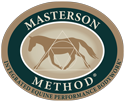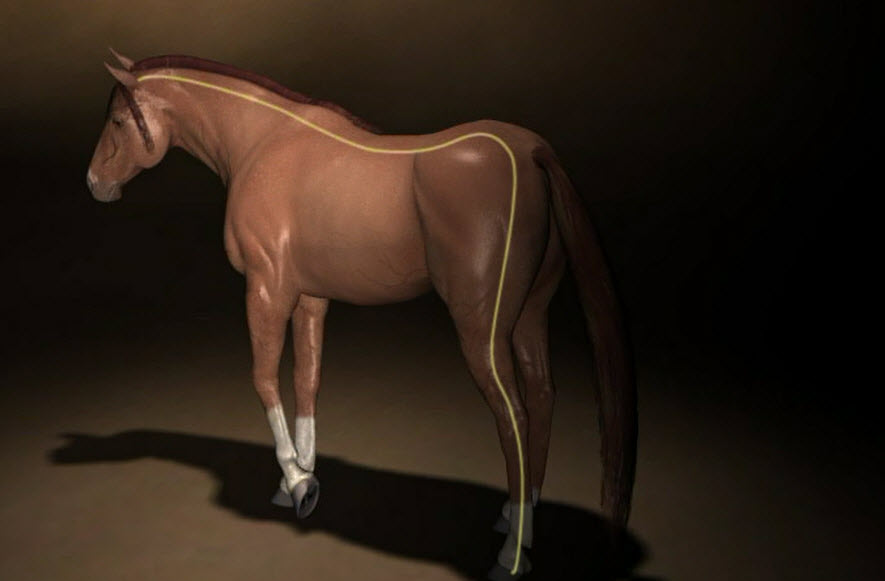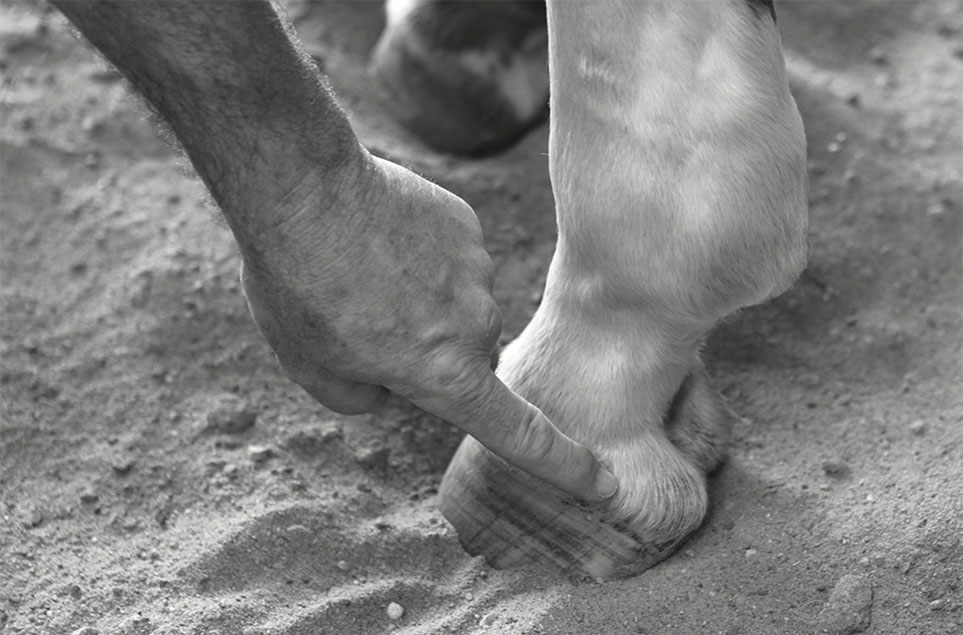Where is the Bladder Meridian on a Horse?
The bladder meridian runs along each side of the horse’s body parallel to and just below the topline. It begins just behind the eye and runs over the poll (between the ears) and down the neck, withers, back and croup, about 2 to 3 inches below the topline. From there, it goes through the poverty groove or the crease between the hamstrings muscles and down the hind leg, side of the hock, down the tendon area just behind the cannon bone (still on the side), over the side of the fetlock and pastern, and down to what’s called the “ting” point in Chinese medicine, which is on the coronary band (see photo).
Goal: To bypass the horse’s survival-defense response and connect directly with the part of the horse’s nervous system that holds and releases tension.
Results: This simple yet powerful Technique establishes the basis of communication between you and the horse through touch and response. It puts you both on the same page, sets the tone for the interaction, and relaxes the horse and you.
Step by Step Instructions
Step 1 – SEARCH • Stand at the horse’s head on the left side. Place the flats of your fingertips, or cup the palm of your hand above the eye, or on the poll just behind the left ear. Barely touching the surface of the skin, slowly (it should take about a minute to run your hand from the poll to the withers) run your hand down the bladder meridian.
Step 2 – RESPONSE • As you move your hand/fingers down the meridian watch closely for subtle signs, or responses from the horse.
Step 3 – STAY • As your hand or fingers pass over a spot that causes the horse to respond, rest your hand/fingers over that spot, keeping your hand soft and the pressure light. Stay on that spot, watching the horse’s responses. This may take one second, or one minute. Be patient. Breathe and relax!
Step 4 – RELEASE • When the horse shows a larger response of RELEASE, such as licking and chewing, yawning, shaking the head, snorting, or sneezing repeatedly, then continue down the meridian repeating these steps.
Bladder Meridian Tips
Go Softly.
Use what we call “air gap” pressure with this technique, or barely touching. If the horse is not responding, raise your hand farther off the horse. Some horses are so sensitive that it will be necessary to have your hand several inches off the horse. Also, check how hard your hand is. Our hands can be lightly touching the horse but remain hard or tense. If your hand is tense, it will make it harder for the horse to release.
Go Slowly.
Forget the clock. It’s important not to have an agenda or feel rushed when doing the Bladder Meridian. Sometimes, it’s hard not to have an agenda – finish this lesson so we can move on to the next one. When we feel rushed or anxious, the horse will sense it, making it harder to do this exercise. Before going into the stall, take a deep breath and relax.
Become familiar with the Search, Response, Stay, Release Technique on pages 10 – 12 in the Beyond Horse Massage book.
Other Tips
- If you’re not sure that the horse blinked because of you or because of something else, go over that spot again (very lightly) and see if the horse blinks at that same spot. If he does, something’s there.
- If your arm gets tired, you can switch hands any time.
- It’s OK to go over a spot twice, miss an area, or not get the both sides of the horse done. That doesn’t mean he’ll go in circles for the rest of his life. The main goal of this exercise is the connection you’re building with the horse.
- You may stop and hold your hand on a certain spot at any time if you sense that by staying may get a release.
- You can start over, or in a different place. You may switch hands, use both hands, stop and begin again, or retrace and go back over an area or spot. Don’t worry, if you do this wrong your horse won’t self-destruct or start to smoke.
- Sometimes, you will stop to see if the horse has more to release and nothing happens. That’s OK. It may mean there was nothing there, there was something there and the horse didn’t release it, or the horse released it and didn’t show you. It’s not the end of the world. Just move on. In most cases, the horse didn’t want to show you the release, and will release after you’ve moved on.
- If you have finished one side of the Bladder Meridian in less than five minutes, you may need to get the clock back out and slow down a bit.
Additional Resources
For more detailed instruction see the Beyond Horse Massage book or the Beyond Horse Massage Home Study Course and consider enrolling in an in-person Masterson Method Course.
This Practice Guide was adapted from the Beyond Horse Massage Home Study Course.



